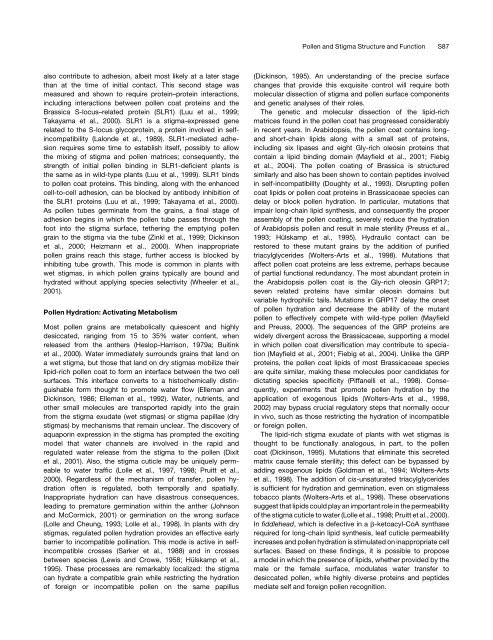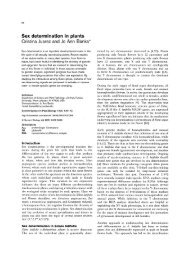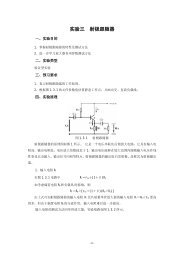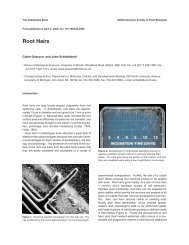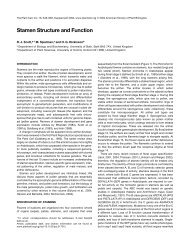Pollen and Stigma Structure and Function: The Role of Diversity in ...
Pollen and Stigma Structure and Function: The Role of Diversity in ...
Pollen and Stigma Structure and Function: The Role of Diversity in ...
You also want an ePaper? Increase the reach of your titles
YUMPU automatically turns print PDFs into web optimized ePapers that Google loves.
<strong>Pollen</strong> <strong>and</strong> <strong>Stigma</strong> <strong>Structure</strong> <strong>and</strong> <strong>Function</strong><br />
S87<br />
also contribute to adhesion, albeit most likely at a later stage<br />
than at the time <strong>of</strong> <strong>in</strong>itial contact. This second stage was<br />
measured <strong>and</strong> shown to require prote<strong>in</strong>–prote<strong>in</strong> <strong>in</strong>teractions,<br />
<strong>in</strong>clud<strong>in</strong>g <strong>in</strong>teractions between pollen coat prote<strong>in</strong>s <strong>and</strong> the<br />
Brassica S-locus–related prote<strong>in</strong> (SLR1) (Luu et al., 1999;<br />
Takayama et al., 2000). SLR1 is a stigma-expressed gene<br />
related to the S-locus glycoprote<strong>in</strong>, a prote<strong>in</strong> <strong>in</strong>volved <strong>in</strong> self<strong>in</strong>compatibility<br />
(Lalonde et al., 1989). SLR1-mediated adhesion<br />
requires some time to establish itself, possibly to allow<br />
the mix<strong>in</strong>g <strong>of</strong> stigma <strong>and</strong> pollen matrices; consequently, the<br />
strength <strong>of</strong> <strong>in</strong>itial pollen b<strong>in</strong>d<strong>in</strong>g <strong>in</strong> SLR1-deficient plants is<br />
the same as <strong>in</strong> wild-type plants (Luu et al., 1999). SLR1 b<strong>in</strong>ds<br />
to pollen coat prote<strong>in</strong>s. This b<strong>in</strong>d<strong>in</strong>g, along with the enhanced<br />
cell-to-cell adhesion, can be blocked by antibody <strong>in</strong>hibition <strong>of</strong><br />
the SLR1 prote<strong>in</strong>s (Luu et al., 1999; Takayama et al., 2000).<br />
As pollen tubes germ<strong>in</strong>ate from the gra<strong>in</strong>s, a f<strong>in</strong>al stage <strong>of</strong><br />
adhesion beg<strong>in</strong>s <strong>in</strong> which the pollen tube passes through the<br />
foot <strong>in</strong>to the stigma surface, tether<strong>in</strong>g the empty<strong>in</strong>g pollen<br />
gra<strong>in</strong> to the stigma via the tube (Z<strong>in</strong>kl et al., 1999; Dick<strong>in</strong>son<br />
et al., 2000; Heizmann et al., 2000). When <strong>in</strong>appropriate<br />
pollen gra<strong>in</strong>s reach this stage, further access is blocked by<br />
<strong>in</strong>hibit<strong>in</strong>g tube growth. This mode is common <strong>in</strong> plants with<br />
wet stigmas, <strong>in</strong> which pollen gra<strong>in</strong>s typically are bound <strong>and</strong><br />
hydrated without apply<strong>in</strong>g species selectivity (Wheeler et al.,<br />
2001).<br />
<strong>Pollen</strong> Hydration: Activat<strong>in</strong>g Metabolism<br />
Most pollen gra<strong>in</strong>s are metabolically quiescent <strong>and</strong> highly<br />
desiccated, rang<strong>in</strong>g from 15 to 35% water content, when<br />
released from the anthers (Heslop-Harrison, 1979a; Buit<strong>in</strong>k<br />
et al., 2000). Water immediately surrounds gra<strong>in</strong>s that l<strong>and</strong> on<br />
a wet stigma, but those that l<strong>and</strong> on dry stigmas mobilize their<br />
lipid-rich pollen coat to form an <strong>in</strong>terface between the two cell<br />
surfaces. This <strong>in</strong>terface converts to a histochemically dist<strong>in</strong>guishable<br />
form thought to promote water flow (Elleman <strong>and</strong><br />
Dick<strong>in</strong>son, 1986; Elleman et al., 1992). Water, nutrients, <strong>and</strong><br />
other small molecules are transported rapidly <strong>in</strong>to the gra<strong>in</strong><br />
from the stigma exudate (wet stigmas) or stigma papillae (dry<br />
stigmas) by mechanisms that rema<strong>in</strong> unclear. <strong>The</strong> discovery <strong>of</strong><br />
aquapor<strong>in</strong> expression <strong>in</strong> the stigma has prompted the excit<strong>in</strong>g<br />
model that water channels are <strong>in</strong>volved <strong>in</strong> the rapid <strong>and</strong><br />
regulated water release from the stigma to the pollen (Dixit<br />
et al., 2001). Also, the stigma cuticle may be uniquely permeable<br />
to water traffic (Lolle et al., 1997, 1998; Pruitt et al.,<br />
2000). Regardless <strong>of</strong> the mechanism <strong>of</strong> transfer, pollen hydration<br />
<strong>of</strong>ten is regulated, both temporally <strong>and</strong> spatially.<br />
Inappropriate hydration can have disastrous consequences,<br />
lead<strong>in</strong>g to premature germ<strong>in</strong>ation with<strong>in</strong> the anther (Johnson<br />
<strong>and</strong> McCormick, 2001) or germ<strong>in</strong>ation on the wrong surface<br />
(Lolle <strong>and</strong> Cheung, 1993; Lolle et al., 1998). In plants with dry<br />
stigmas, regulated pollen hydration provides an effective early<br />
barrier to <strong>in</strong>compatible poll<strong>in</strong>ation. This mode is active <strong>in</strong> self<strong>in</strong>compatible<br />
crosses (Sarker et al., 1988) <strong>and</strong> <strong>in</strong> crosses<br />
between species (Lewis <strong>and</strong> Crowe, 1958; Hülskamp et al.,<br />
1995). <strong>The</strong>se processes are remarkably localized: the stigma<br />
can hydrate a compatible gra<strong>in</strong> while restrict<strong>in</strong>g the hydration<br />
<strong>of</strong> foreign or <strong>in</strong>compatible pollen on the same papillus<br />
(Dick<strong>in</strong>son, 1995). An underst<strong>and</strong><strong>in</strong>g <strong>of</strong> the precise surface<br />
changes that provide this exquisite control will require both<br />
molecular dissection <strong>of</strong> stigma <strong>and</strong> pollen surface components<br />
<strong>and</strong> genetic analyses <strong>of</strong> their roles.<br />
<strong>The</strong> genetic <strong>and</strong> molecular dissection <strong>of</strong> the lipid-rich<br />
matrices found <strong>in</strong> the pollen coat has progressed considerably<br />
<strong>in</strong> recent years. In Arabidopsis, the pollen coat conta<strong>in</strong>s long<strong>and</strong><br />
short-cha<strong>in</strong> lipids along with a small set <strong>of</strong> prote<strong>in</strong>s,<br />
<strong>in</strong>clud<strong>in</strong>g six lipases <strong>and</strong> eight Gly-rich oleos<strong>in</strong> prote<strong>in</strong>s that<br />
conta<strong>in</strong> a lipid b<strong>in</strong>d<strong>in</strong>g doma<strong>in</strong> (Mayfield et al., 2001; Fiebig<br />
et al., 2004). <strong>The</strong> pollen coat<strong>in</strong>g <strong>of</strong> Brassica is structured<br />
similarly <strong>and</strong> also has been shown to conta<strong>in</strong> peptides <strong>in</strong>volved<br />
<strong>in</strong> self-<strong>in</strong>compatibility (Doughty et al., 1993). Disrupt<strong>in</strong>g pollen<br />
coat lipids or pollen coat prote<strong>in</strong>s <strong>in</strong> Brassicaceae species can<br />
delay or block pollen hydration. In particular, mutations that<br />
impair long-cha<strong>in</strong> lipid synthesis, <strong>and</strong> consequently the proper<br />
assembly <strong>of</strong> the pollen coat<strong>in</strong>g, severely reduce the hydration<br />
<strong>of</strong> Arabidopsis pollen <strong>and</strong> result <strong>in</strong> male sterility (Preuss et al.,<br />
1993; Hülskamp et al., 1995). Hydraulic contact can be<br />
restored to these mutant gra<strong>in</strong>s by the addition <strong>of</strong> purified<br />
triacylglycerides (Wolters-Arts et al., 1998). Mutations that<br />
affect pollen coat prote<strong>in</strong>s are less extreme, perhaps because<br />
<strong>of</strong> partial functional redundancy. <strong>The</strong> most abundant prote<strong>in</strong> <strong>in</strong><br />
the Arabidopsis pollen coat is the Gly-rich oleos<strong>in</strong> GRP17;<br />
seven related prote<strong>in</strong>s have similar oleos<strong>in</strong> doma<strong>in</strong>s but<br />
variable hydrophilic tails. Mutations <strong>in</strong> GRP17 delay the onset<br />
<strong>of</strong> pollen hydration <strong>and</strong> decrease the ability <strong>of</strong> the mutant<br />
pollen to effectively compete with wild-type pollen (Mayfield<br />
<strong>and</strong> Preuss, 2000). <strong>The</strong> sequences <strong>of</strong> the GRP prote<strong>in</strong>s are<br />
widely divergent across the Brassicaceae, support<strong>in</strong>g a model<br />
<strong>in</strong> which pollen coat diversification may contribute to speciation<br />
(Mayfield et al., 2001; Fiebig et al., 2004). Unlike the GRP<br />
prote<strong>in</strong>s, the pollen coat lipids <strong>of</strong> most Brassicaceae species<br />
are quite similar, mak<strong>in</strong>g these molecules poor c<strong>and</strong>idates for<br />
dictat<strong>in</strong>g species specificity (Piffanelli et al., 1998). Consequently,<br />
experiments that promote pollen hydration by the<br />
application <strong>of</strong> exogenous lipids (Wolters-Arts et al., 1998,<br />
2002) may bypass crucial regulatory steps that normally occur<br />
<strong>in</strong> vivo, such as those restrict<strong>in</strong>g the hydration <strong>of</strong> <strong>in</strong>compatible<br />
or foreign pollen.<br />
<strong>The</strong> lipid-rich stigma exudate <strong>of</strong> plants with wet stigmas is<br />
thought to be functionally analogous, <strong>in</strong> part, to the pollen<br />
coat (Dick<strong>in</strong>son, 1995). Mutations that elim<strong>in</strong>ate this secreted<br />
matrix cause female sterility; this defect can be bypassed by<br />
add<strong>in</strong>g exogenous lipids (Goldman et al., 1994; Wolters-Arts<br />
et al., 1998). <strong>The</strong> addition <strong>of</strong> cis-unsaturated triacylglycerides<br />
is sufficient for hydration <strong>and</strong> germ<strong>in</strong>ation, even on stigmaless<br />
tobacco plants (Wolters-Arts et al., 1998). <strong>The</strong>se observations<br />
suggest that lipids could play an important role <strong>in</strong> the permeability<br />
<strong>of</strong> the stigma cuticle to water (Lolle et al., 1998; Pruitt et al., 2000).<br />
In fiddlehead, which is defective <strong>in</strong> a b-ketoacyl-CoA synthase<br />
required for long-cha<strong>in</strong> lipid synthesis, leaf cuticle permeability<br />
<strong>in</strong>creases <strong>and</strong> pollen hydration is stimulated on <strong>in</strong>appropriate cell<br />
surfaces. Based on these f<strong>in</strong>d<strong>in</strong>gs, it is possible to propose<br />
a model <strong>in</strong> which the presence <strong>of</strong> lipids, whether provided by the<br />
male or the female surface, modulates water transfer to<br />
desiccated pollen, while highly diverse prote<strong>in</strong>s <strong>and</strong> peptides<br />
mediate self <strong>and</strong> foreign pollen recognition.


